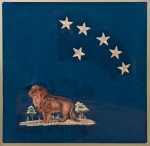UNIFORM GUIDELINES PAGE 2
1. Fatigue Blouse (or Sack Coat): The fatigue blouse's basic features include a indigo dyed (a rich dark blue with a greenish tinge,NOT the blackish navy blue which fades to an even more unacceptable purple color) wool flannel with a diagonal weave, a kidney shaped or square corner interior pocket, four 3/4 inch general service eagle buttons, small cuff vents, and a falling collar. Our fatigue blouses are either lined or unlined, but lined fatigue blouses (which were in the majority) are preferred. Wool flannel lining can be tan, gray, brown, or blue with corresponding cotton muslin sleeve lining and hand-sewn sleeves between body of the coat and sleeve lining. Unlined coats should have hand flat felled seams. All buttonholes shall be entirely hand sewn using blue, black, or logwood faded (brown) linen or cotton thread.
Approved styles include Schuylkill Arsenal Pattern (entirely hand sewn), J.T. Martin contract pattern & other documented arsenal and contract patterns.
2. Trousers (Foot Pattern): Some basic features include a greenish cast sky blue kersey wool with a diagonal weave, correct rise of trousers in the seat (back yoke), right side watch pocket, narrow tapered waistband, four or six stamped paper backed tin suspender buttons, five small paper back tin fly buttons, side seam pockets, correct overlapping cuff vents with internal cuff facings, correct fly panels and facings, etc. Buttonholes and tieback grommet holes should be hand sewn with dark blue or logwood-dyed cotton or linen thread.
Approved styles include Schuylkill Arsenal pattern (entirely hand sewn), J.T. Martin contract pattern, William Deering contract pattern & other documented arsenal and contract patterns.
3. Undecorated U.S. Pattern 1858 Dress Hat: Made of black rabbit or wool felt, with a 2.5 inch black leather sweatband, the hat has a 3 inch brim, 5.5 inch crown height, has double row brim stitching at 4 stitches per inch, a black silk grosgrain ribbon surrounding the base of the crown, and a black oilcloth or paper crown label.
4. Forage Cap: So- called Type 1 (typically a smaller curved brim) which is preferred or so- called Type 2 (typically a larger rectangular brim) patterns acceptable. Made of finely woven indigo dyed wool flannel, with a polished cotton lining of black or dark brown, hand sewn sweatband, thin painted leather black brim, chin strap, and two 5/8 inch general service eagle buttons attached on each side of the chin strap. The forage cap is not to be worn like a baseball cap. Seek out period field photographs for the correct way to push up your brim. Arsenal or contract patterns based off of originals are acceptable.
5. Civilian Hat: Documented pattern, construction, and materials only. The Board of the 24th Missouri views the wearing of civilian hats to be strictly scenario specific, and not worn as a general rule of thumb. Their use should be limited to a popular style of hat available to troops such as the plug, porkpie, or slouch. Correct brim edging, lining, and sweatband per original specimens.
6. U.S. Pattern Jefferson Bootees: Black dyed, semi roughed out leather, squared front, one inch heels, four sets of shoelace holes with one in the vamp, accompanied with leather shoelaces. Leather soles can be either pegged or sewn. Heel rims, inlet heel rims, and hobnails are all acceptable.
7. Civilian Shirt: Must be of period fabric and construction. The body of the shirt may be either hand or machine stitched, but entirely hand sewn civilian shirts (which were more common) are preferred. All buttons & buttonholes shall be entirely sewn by hand. Hand felled seams helped to prevent fraying, and was another very common sewing detail found in civilian shirts. Look for two to three colored woven shirt patterns such as small plaids, checks, & stripes. The woven shirt patterns should be the same on the reverse side of the shirting fabric. Civilian shirt fabrics should be of 100% cotton. Look for small folding or banded collars, and three or four button plackets. Civilian shirts can have square gussets as popular in the 1850's, or the rounded sleeves, which became stylish during the 1860's. Correct buttons were comprised of bone, shell, china, milk glass, hard rubber, or wood in two or four hole styles. Small size buttons ranging from 3/8 of an inch to 1/2 of an inch in diameter are preferred. If practical, four hole style buttons should be sewn on such that the thread forms an "X" between the button holes.
8. Federal Issue Shirt: Made of domet wool flannel, completely hand sewn rectangular body with square gussets. It is off white or cream-colored flannel (wool on a cotton warp) with a reinforced slit front opening, a squared collar closed by a single stamped sheet iron button, tapered sleeves with internally faced cuffs formed as part of the sleeve and closed by single buttons, a reinforcing strap across the top of the shoulder, and very full cut in the body. Also acceptable are the gray wool flannel contract variant issue shirts, which may feature a three-button placket, no sleeve gussets, machine-sewn body, and the use of stamped tin buttons.


